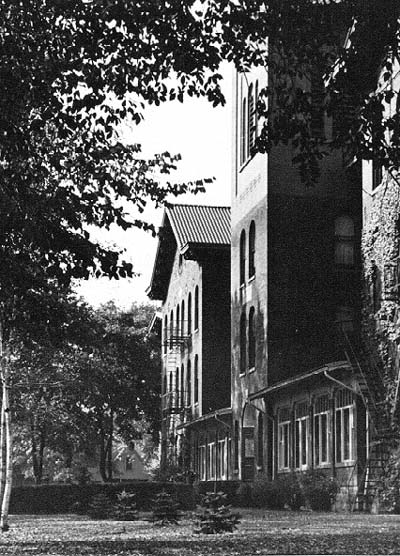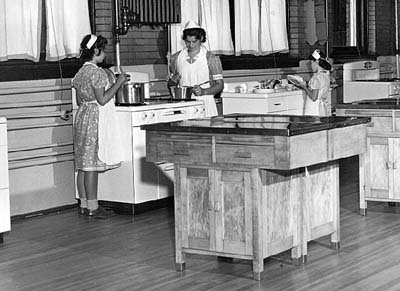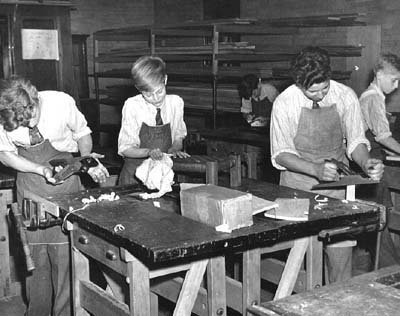
front section of the building

Building through the front door. The statue of the Guardian Angel was the first object that came into view.


| On Ash Wednesday, March 5, 1919, the institution was razed by a devastating fire. The Sister Superior going to the basement to light up the newly installed rooms of the cooking class, in order to show them to the Board of Directors which was meeting that evening, discovered the fire at the west end of the basement and immediately turned in an alarm. The smoke and fire was making rapid progress up a small dumb-waiter to the upper floors. | ||||||||||||||||||||||||||||||||||||||||||||||||||||||||||||
 |
||||||||||||||||||||||||||||||||||||||||||||||||||||||||||||
| The younger boys and all the girls were already in bed. They rather resented the signal for fire drill as they had had one that morning and considered two fire drills in one day too many. They were soon out of the west wing of the building and gathered in the girl's hall in the east wing. Many of the boys were wrapped in blankets as they had no time to put on their outer clothing. After reaching the third floor, the fire spread, burning off the roof and tower. The cross on the tower was loosened and fell burying itself in the lawn. The entire building finally had to be evacuated. The children were transferred to the laundry and shades were drawn to keep out the sight of the burning building as much as possible. People living in the neighborhood took as many children as their homes could accommodate. The Convent of the Good Shepherd, the Christian Brothers, Canisius College and High School also took in some of the children. As the younger children's dormitories were unharmed, this group was finally returned to bed. The fire was under control by midnight. The center building suffered the greatest damage. The school rooms were not usable. By Monday, March 10, 1919, the desks were moved to the dormitories and regular school sessions were held. The beds were pulled out each morning and replaced by the desks. | ||||||||||||||||||||||||||||||||||||||||||||||||||||||||||||
| A close-up view of the rebuilt front section of the building |
||||||||||||||||||||||||||||||||||||||||||||||||||||||||||||
| Although the loss was considered great at the time, it later proved to be a blessing in disguise. In an account of the disaster the Sister Secretary who was present at the time, told a story which has become a tradition in the institution. It has reference to the beautiful picture of St. joseph which now occupies a place of honor in the parlor. This picture hung in the mail hall and afte the fire it was still there, unharmed, while the sections surrounding it were so badly burnt it was considered dangerous to remove it. | ||||||||||||||||||||||||||||||||||||||||||||||||||||||||||||
 |
||||||||||||||||||||||||||||||||||||||||||||||||||||||||||||
| A view of the "Front Office" as you entered the Main Building through the front door. The statue of the Guardian Angel was the first object that came into view. |
||||||||||||||||||||||||||||||||||||||||||||||||||||||||||||
| After several months of this exposure, the roof and nearby supports were destroyed due to heavy rains and prevailing storms, so the Sister ordered some scaffolding erected and the picture, still in perfect condition was removed. The following day the wall which had supported the picture collapsed completely. | ||||||||||||||||||||||||||||||||||||||||||||||||||||||||||||
| Within six months the institution was completely rebuilt. Profiting by the tragic experience many improvements were added. A porch was added to the front of the main building. It extended almost across the entire front of the building and was enclosed on one side with an attractive sun parlor and on the other side with four private offices for the Sisters in charge. | ||||||||||||||||||||||||||||||||||||||||||||||||||||||||||||
| Plans were made to erect a school building separate from the main building. But it was only in 1927 that these plans materialized. The cornerstone was laid July 11, 1927. "The new building contains the eight preliminary grades, besides the kindergarten and ungraded class. The nine teaching Sisters are qualified by the New York State Board of Regents and under the supervision of the local Board of Education. Besides these teaching Sisters, the ungraded class, the kindergarten, the gymnasium classes, manual training, physical training and home-making classes are taught by lay teachers supplied by the Board of Education. | ||||||||||||||||||||||||||||||||||||||||||||||||||||||||||||
 |
||||||||||||||||||||||||||||||||||||||||||||||||||||||||||||
 |
Girls in the Home Economics Classroom | |||||||||||||||||||||||||||||||||||||||||||||||||||||||||||
| Speech correction classes are also held twice a week. The work of the school is directed not only toward the formal scholastic and industrial training of its inmates, but even more towards the inculcation of high ideals and standards of character, conduct, and economic independence. | ||||||||||||||||||||||||||||||||||||||||||||||||||||||||||||
| Plans were likewise made shortly after the fire of 1919 for a new chapel but these plans failed to materialize until 1938. The chapel was likewise a separate unit from the main building, being connected with it only by a corridor. The track team from GRCO Home won the Parochial Track Meet in June 1929 and the prizes were personally presented by Bishop William Turner. | ||||||||||||||||||||||||||||||||||||||||||||||||||||||||||||
| History Pg. 3 | History Pg. 4 | History Pg. 5 | ||||||||||||||||||||||||||||||||||||||||||||||||||||||||||
| History Pg. 1 | History Pg. 2 | |||||||||||||||||||||||||||||||||||||||||||||||||||||||||||
| History Pg. 8 | ||||||||||||||||||||||||||||||||||||||||||||||||||||||||||||
| History Pg. 7 | ||||||||||||||||||||||||||||||||||||||||||||||||||||||||||||
| History Pg. 6 | History Pg. 9 | |||||||||||||||||||||||||||||||||||||||||||||||||||||||||||
| Home Page | ||||||||||||||||||||||||||||||||||||||||||||||||||||||||||||